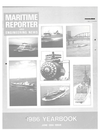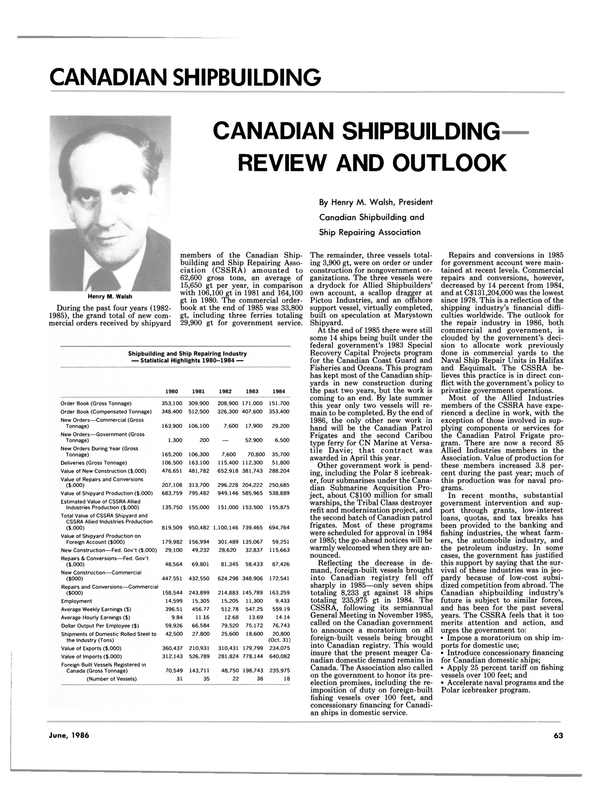
CANADIAN SHIPBUILDING REVIEW AND OUTLOOK
During the past four years (1982- 1985), the grand total of new commercial orders received by shipyard members of the Canadian Shipbuilding and Ship Repairing Association (CSSRA) amounted to 62,600 gross tons, an average of 15,650 gt per year, in comparison with 106,100 gt in 1981 and 164,100 gt in 1980. The commercial orderbook at the end of 1985 was 33,800 gt, including three ferries totaling 29,900 gt for government service.
The remainder, three vessels totaling 3,900 gt, were on order or under construction for nongovernment organizations.
The three vessels were a drydock for Allied Shipbuilders' own account, a scallop dragger at Pictou Industries, and an offshore support vessel, virtually completed, built on speculation at Marystown Shipyard.
At the end of 1985 there were still some 14 ships being built under the federal government's 1983 Special Recovery Capital Projects program for the Canadian Coast Guard and Fisheries and Oceans. This program has kept most of the Canadian shipyards in new construction during the past two years, but the work is coming to an end. By late summer this year only two vessels will remain to be completed. By the end of 1986, the only other new work in hand will be the Canadian Patrol Frigates and the second Caribou type ferry for CN Marine at Versatile Davie; that contract was awarded in April this year.
Other government work is pending, including the Polar 8 icebreaker, four submarines under the Canadian Submarine Acquisition Project, about C$100 million for small warships, the Tribal Class destroyer refit and modernization project, and the second batch of Canadian patrol frigates. Most of these programs were scheduled for approval in 1984 or 1985; the go-ahead notices will be warmly welcomed when they are announced.
Reflecting the decrease in demand, foreign-built vessels brought into Canadian registry fell off sharply in 1985—only seven ships totaling 8,233 gt against 18 ships totaling 235,975 gt in 1984. The CSSRA, following its semiannual General Meeting in November 1985, called on the Canadian government to announce a moratorium on all foreign-built vessels being brought into Canadian registry. This would insure that the present meager Canadian domestic demand remains in Canada. The Association also called on the government to honor its preelection promises, including the reimposition of duty on foreign-built fishing vessels over 100 feet, and concessionary financing for Canadian ships in domestic service.
Repairs and conversions in 1985 for government account were maintained at recent levels. Commercial repairs and conversions, however, decreased by 14 percent from 1984, and at C$131,204,000 was the lowest since 1978. This is a reflection of the shipping industry's financial difficulties worldwide. The outlook for the repair industry in 1986, both commercial and government, is clouded by the government's decision to allocate work previously done in commercial yards to the Naval Ship Repair Units in Halifax and Esquimalt. The CSSRA believes this practice is in direct conflict with the government's policy to privatize government operations.
Most of the Allied Industries members of the CSSRA have experienced a decline in work, with the exception of those involved in supplying components or services for the Canadian Patrol Frigate program.
There are now a record 85 Allied Industries members in the Association. Value of production for these members increased 3.8 percent during the past year; much of this production was for naval programs.
In recent months, substantial government intervention and support through grants, low-interest loans, quotas, and tax breaks has been provided to the banking and fishing industries, the wheat farmers, the automobile industry, and the petroleum industry. In some cases, the government has justified this support by saying that the survival of these industries was in jeopardy because of low-cost subsidized competition from abroad. The Canadian shipbuilding industry's future is subject to similar forces, and has been for the past several years. The CSSRA feels that it too merits attention and action, and urges the government to: • Impose a moratorium on ship imports for domestic use; • Introduce concessionary financing for Canadian domestic ships; • Apply 25 percent tariff on fishing vessels over 100 feet; and • Accelerate naval programs and the Polar icebreaker program.
Read CANADIAN SHIPBUILDING REVIEW AND OUTLOOK in Pdf, Flash or Html5 edition of June 1986 Maritime Reporter
Other stories from June 1986 issue
Content
- Zapata Gulf Acquires All Assets Of Seahorse page: 5
- Rody Selects AWSC Committee Chairmen page: 5
- Danos & Curole Continue Long-Range Expansion In Marine Department page: 5
- Contract With $25-Million Potential Awarded Rockwell page: 6
- Nelson Electric Names Sanchez Sales Manager page: 6
- Bailey Refrigeration Goes On Site For Work Aboard Navy Aircraft Carrier page: 7
- Navy Awards $73.7-Million Crane Contract To Craft Machine page: 7
- ABS Elects New Members To Board Of Managers page: 8
- ASNE Symposium-1986 Set For October 2-4 In Biloxi, Miss. page: 8
- Ulstein Delivers Two Tug/Supply Vessels To Norwegian Owners page: 10
- Derecktor Delivers First Of Two Ferries To New York City page: 11
- AWO Elects Officers For 1986 At Annual Convention In Washington page: 11
- Pentagon Approves $216-Million Sale To Portugese Navy page: 12
- Sophisticated Catcher/Processor Delivered By Halter Marine page: 12
- ODECO Wins 1986 NOIA Safety In Seas Award page: 12
- Pickands Mather Promotes Three In Marine Department page: 13
- Monsanto Offers Free 12-Page Bulletin On Fluid Resistance Of Santoprene® page: 14
- Port Of Portland Budget Includes Funds For Marine Improvements page: 15
- American Bureau Names Twenty-Five New Members page: 15
- Port Authority In Malaysia Orders Voith Water Tractor page: 16
- Gastech 85 "Proceedings' Now Available page: 16
- Metos Marine Offers New Cabin Fitting Concept page: 17
- Meyer Werft Launches Two Sister Passenger Ships For Indonesia page: 18
- Fairbanks Morse Invests In Future— Expands Parts/Service Operations, Increases Production And R&D page: 20
- Borg-Warner Changes Name To York International page: 23
- Passenger Catamaran To Operate Between Seattle And Victoria page: 24
- U.S. SHIPBUILDING $Billions In Navy Work Plus Repairs Brighten The Picture page: 26
- STATUS OF NAVY SHIP PROCUREMENT page: 32
- U.S. SHIPBUILDING OUTLOOK Maritime Policy—1980-1985 page: 40
- U.S. SHIPBUILDING INDUSTRY HAS MADE GREAT STRIDES IN IMPROVING EFFICIENCY AND REDUCING COSTS page: 44
- Our Transportation Policy Is No Transporation Policy page: 46
- REGULATORY OVERKILL PERSERVERES page: 48
- AWSC And The Industry: Working For The Future page: 50
- Offshore Service Vessels, Tugboat And Inland Towboat Fleets page: 52
- CANADIAN SHIPBUILDING REVIEW AND OUTLOOK page: 63
- World Shipping And Shipbuilding page: 65
- Port of Iberia Inaugurates New Public Dock Facility page: 72
- Amhoist Announces $33 Million In Crane And Puller Orders page: 72
- Hancock Succeeds Loftus As Comptroller And Deputy Commander Of NAVSEA page: 73
- Gastech 86 Scheduled For November In Hamburg page: 73
- Technical Report On Liner And Bulk Planning Systems Offered By MarAd page: 74
- Todd's San Pedro Yard Gets Preliminary Approval As Foreign Trade Subzone page: 74
- Beclawat Offers Windows & Doors For Ships And Rigs page: 74
- Wartsila Unit Offers Vacuum Toilet System page: 75
- Ship Structure Committee Releases New Reports On Design And Safety Topics page: 75
- BIRKA LINE CRUISE SHIP DELIVERED BY VALMET page: 76
- American Management Now Provides Services For Commercial Ships page: 77
- Two More Firms Approve Use Of Ameroid® OWS page: 77
- MarAd Invites Proposals To Provide Vessel For Schoolship Conversion page: 77
- Port Authority Urges $56.5-Million In Funds For N.Y. Harbor Improvements page: 78
- Marine Travelift Offers Full-Color Brochure On 250-Ton Mobile Boat Hoist page: 78
- Bailey Controls Offers 18-Page Technical Paper On 0 2 / C 0 Boiler Control page: 78
- William O'Malley Named Executive VP At Sonat page: 79
- Free Literature Available On Long-Life Marine Window Wipers For Ships page: 79
- Jane's Publishing Offers Facsimile Edition Of First World's Fighting Ships page: 80
- Baldt Offers Military Shipbuilding Brochure page: 80
- York International Offers Brochure On Water Chilling And Condensing Units page: 81
- Norsk Pacific Announces Management Changes— Stenstrom Named President page: 81
- Deepwater, Heavy-Duty Jackup Joins Blue Streak Marine Fleet page: 82
- New Brochure Offered By Warren Describes Barge Pump Line page: 82
- M.A.N.-B&W Turbochargers Reduce Fuel Consumption page: 83
- SNAME Announces Standing Special And Technical Committees For 1986 page: 84
- Free 72-Page Catalog Describes New Falk Worm Gear Speed Reducers page: 85
- Free Full-Color Bulletin On AQP Spiral Wire Hose Offered By Aeroquip page: 86
- PRMMI Names Four To Key Sales Positions page: 86
- MHI Develops High-Pressure Gas Injection DFD Engine page: 87
- Free Four-Page Brochure Offered On Acorn Platens page: 87
- 'New' High-Speed Ferry Boosts Boston Area Commuter Service page: 88
- Microphor Offers New Four-Color Brochure On Marine Heads page: 89
- Cat Pumps Introduces Two N e w Stainless Steel Pumps page: 90
- Polarmarine Introduces New Concept In Tank Cleaning page: 91
- Tampa Shipyards Delivers Fifth Products Tanker To Ocean Shipholdings page: 92
- Caterpillar 3600 Series Now Qualified On 1,500 Redwood Fuel page: 92
- Bailey Controls Opens New Demonstration Facility page: 93
- Ulstein Maritime Reports On Z-Drive Success page: 94
- Degree In Small Craft Naval Architecture Offered By YDI Schools page: 95
- Montreal Group Plans To Modernize 150-Year-Old Yard In Nova Scotia page: 96
- Atlas-Danmark Expands Line Of Sludge/Waste Incinerators page: 97
- '86 Ship Production Symposium Scheduled For August in Williamsburg page: 98
- Sulzer Diesels Will Power Townsend Cross-Channel Passenger/Vehicle Ferries page: 99
- Marathon Offers Full-Color Brochure On Metal Fabrication Services page: 102
- Free 12-Page Catalog On Combustion, Pollution And Energy Control Equipment page: 102
- Free 16-Page Full-Color Brochure On Compressors Offered By Atlas Copco page: 103
- MM A Meeting Draws Immediate Return Engagement By DLA's General Morgan page: 104
- SAIT Radio Telex Now Compatible With IBM PC page: 104
- New York City Marine Society Celebrates 216th Annual Dinner page: 106
- Blount Marine Delivers 64-Foot Ferry To Prudence Island Navigation page: 109
- First Two Of Ten Bulkers For Greek Owner Christened At Hyundai page: 115
- The Shipmate RS-2000 Color Track Plotter page: 115
- MacGregor-Navire Link Span Installed At Port Of Plymouth page: 118
- Cathodic/Electrolytic Engineers Offer Replacement Anode Service For Antifouling Systems page: 119
- Record Land And Marine Lifts Set By Amhoist Cranes page: 119


